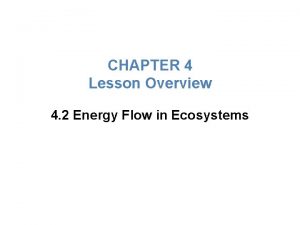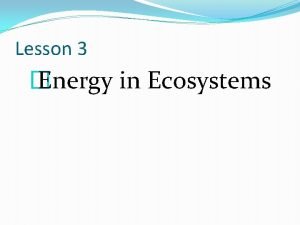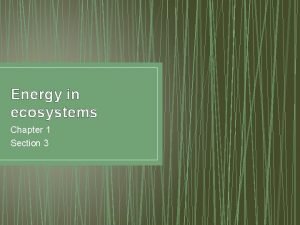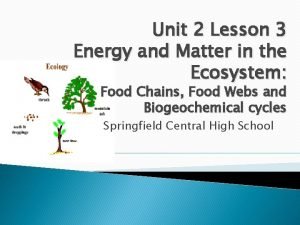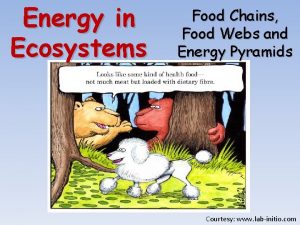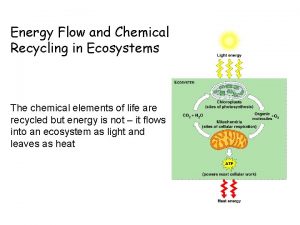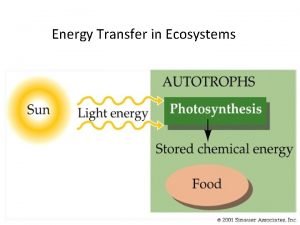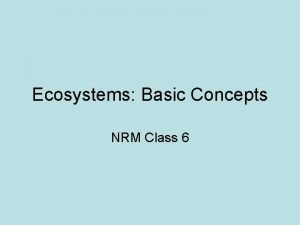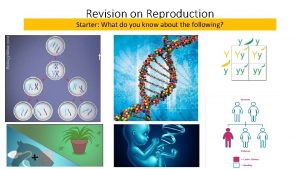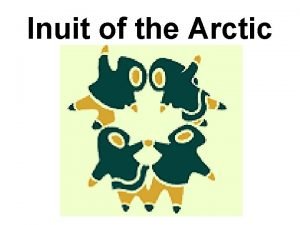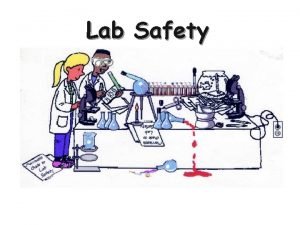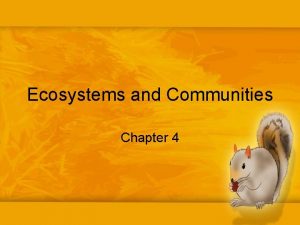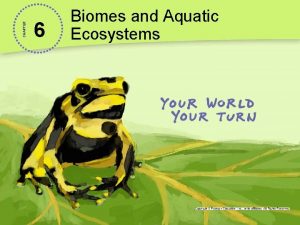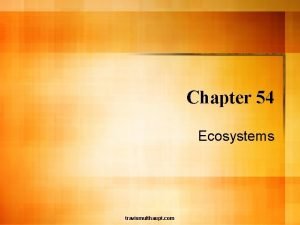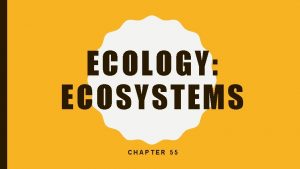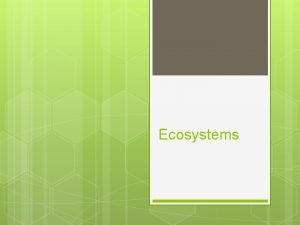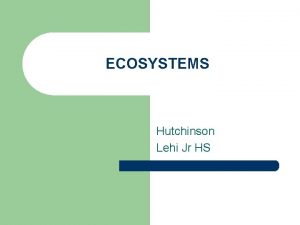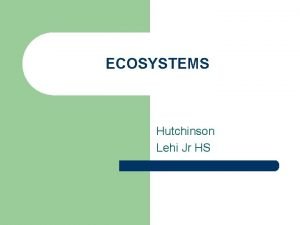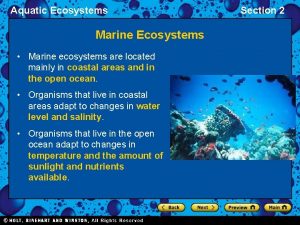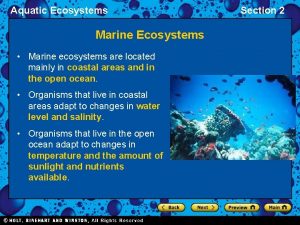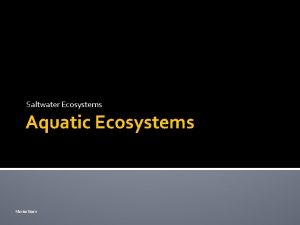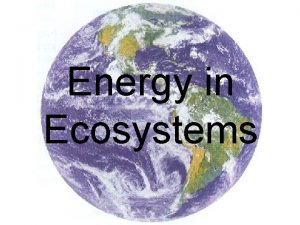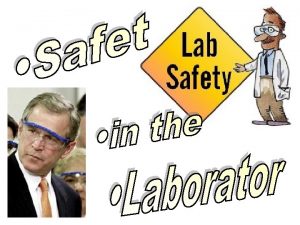Chapter 55 Ecosystems You Must Know How energy

































- Slides: 33

Chapter 55: Ecosystems

You Must Know: • How energy flows through the ecosystem (food chains and food webs) • The difference between gross primary productivity and net primary productivity. • The carbon and nitrogen biogeochemical cycles.

Ecosystems Ecosystem = sum of all the organisms living within its boundaries (biotic community) + _________ factors with which they interact Involves two unique processes: 1. ________________ 2. ________________

Overview of energy & nutrient dynamics

Energy Flow in an Ecosystem • Energy ________________ must be constantly supplied to an ecosystem (mostly by ____) ____ • The __________ (“self feeders”) are the _________________, and are usually _____________ (plants or algae). ▫ They use light energy to synthesize sugars and other organic compounds. • _____________ (“other feeders”) – can’t make own food (consumers)

• Heterotrophs are at trophic levels _______ the primary producers and depend on their photosynthetic output.

▫ Herbivores that eat primary producers are called _______________. ▫ Carnivores that eat herbivores are called _______________. ▫ Carnivores that eat secondary consumers are called _______________. ▫ Another important group of heterotrophs is the ___________, or decomposers. They get energy from detritus, ______________ material, and play an important role in material cycling.

Main decomposers: ________ & ________

Primary Production • Primary production = amt. of ___________that is converted to ___________ • ______ primary production (GPP): total primary production in an ecosystem • ______ primary production (NPP) = gross primary production ______ the energy used by the primary producers for ____________ ▫ NPP = GPP – R • NPP = storage of _________ energy _______ to consumers in an ecosystem

Net primary production of different ecosystems Open ocean Continental shelf Estuary Algal beds and reefs Upwelling zones Extreme desert, rock, sand, ice Desert and semidesert scrub Tropical rain forest Savanna Cultivated land Boreal forest (taiga) Temperate grassland Woodland shrubland Tundra Tropical seasonal forest Temperate deciduous forest Temperate evergreen forest Swamp and marsh Lake and stream 5. 2 0. 3 0. 1 4. 7 3. 5 3. 3 2. 9 2. 7 2. 4 1. 8 1. 7 1. 6 1. 5 1. 3 1. 0 0. 4 0 Key Marine Terrestrial 125 360 65. 0 10 20 30 40 50 60 Percentage of Earth’s surface area Freshwater (on continents) 24. 4 5. 6 1, 500 2, 500 1. 2 0. 9 0. 1 0. 04 0. 9 500 3. 0 90 22 2, 200 7. 9 9. 1 9. 6 5. 4 3. 5 900 600 800 600 700 140 0. 6 7. 1 4. 9 3. 8 2. 3 0. 3 1, 600 1, 200 1, 300 2, 000 250 0 500 1, 000 1, 500 2, 000 2, 500 Average net primary production (g/m 2/yr) 0 10 15 20 25 5 Percentage of Earth’s net primary production

• Primary production affected by: ▫ Light availability (↑ depth = ___ photosynthesis) ▫ ______ availability (N, P in marine env. ) • Key factors controlling primary production: ▫ ________ & ________ • A nutrient-rich lake that supports algae growth is ___________.

Energy transfer between trophic levels is typically only _____% efficient • Production efficiency: only fraction of E stored in food • Energy used in respiration is lost as _______ • Energy ______ (not cycles!) within ecosystems

10% transfer of energy from one level to next

Ecological pyramids give insight to food chains • Loss of energy limits # of top-level carnivores • Most food webs only have 4 or 5 trophic levels Pyramid of Numbers Pyramid of Biomass

The dynamics of energy through ecosystems have important implications for the human population Trophic level Secondary consumers Primary producers

Matter Cycles in Ecosystem • Biogeochemical cycles: nutrient cycles that contain both biotic and abiotic components • organic inorganic parts of an ecosystem • Nutrient Cycles: water, carbon, nitrogen, phosphorus


Water Cycle


Carbon Cycle

Carbon Cycle • CO 2 removed by _______, added by burning fossil fuels

Carbon Cycle 1. What type of organism is MOST important to the C cycle? 2. What part of the cycle is being most endangered by human activity? Why? 3. What would happen if there were no decomposers/ decomposition?

Nitrogen Cycle • Nitrogen fixation: ▫ _______ fixed into usable form by soil _________ for ________ to use • Nitrification: ▫ _________________ ▫ Absorbed by plants • __________: ▫ Release N to atmosphere


Nitrogen Cycle 1. What organisms are KEY to cycling nitrogen in the environment? 2. In what ways is N 2 gas removed from the atmosphere? 3. What do denitrifying bacteria do? Turn & Talk

Nitrogen Sources over time


1. Make a Claim about the graph. 2. Provide evidence to support the claim. 3. Give reasoning to support the claim.

Phosphorus Cycle • Organisms require P for _______, _____, and ________ • _____ absorb inorganic phosphate PO 43 - to synthesize organic compounds • Largest P reservoir is _______; some in ocean and soil too


Decomposition and Nutrient Cycling Decomposition occurs faster in ______ ecosystems

Restoration Ecology • _________________: use of organisms (prokaryotes, fungi, plants) to detoxify and _________ harmful substances from polluted ecosystems • _________________: _______ desirable species (eg. nitrogen-fixers) to add essential nutrients

Bioremediation of groundwater contaminated with uranium Restoration ecology projects
 Chapter 4 lesson 2 energy flow in ecosystems
Chapter 4 lesson 2 energy flow in ecosystems Chapter 42 ecosystems and energy
Chapter 42 ecosystems and energy Energy in ecosystems lesson 3 answer key
Energy in ecosystems lesson 3 answer key Ap calculus stuff you must know cold
Ap calculus stuff you must know cold Https:/ / www.youtube.com/ watch?v=jnj8mc04r9e
Https:/ / www.youtube.com/ watch?v=jnj8mc04r9e Section 3 energy in ecosystems
Section 3 energy in ecosystems How does energy flow in an ecosystem
How does energy flow in an ecosystem Phosphorus cycle
Phosphorus cycle Lab food chains and energy in ecosystems
Lab food chains and energy in ecosystems How does energy move through most ecosystems on earth
How does energy move through most ecosystems on earth Flow of energy
Flow of energy Primary consumers
Primary consumers Section 1 energy flow in ecosystems
Section 1 energy flow in ecosystems Energy transfer in ecosystems
Energy transfer in ecosystems Ecosystem definition class 6
Ecosystem definition class 6 Know history know self
Know history know self Normalizing flow
Normalizing flow God of angel armies
God of angel armies You know minecraft
You know minecraft ,,
,, You're a poet and you don't know it
You're a poet and you don't know it When you're blue and you don't know
When you're blue and you don't know How do you know if you're asexual
How do you know if you're asexual Do you know who you are
Do you know who you are I will follow you follow you wherever
I will follow you follow you wherever Rascal flatts my wish for you
Rascal flatts my wish for you You must unlearn what you have learned
You must unlearn what you have learned Wear goggles in lab
Wear goggles in lab If you love god you must hate evil
If you love god you must hate evil If your homework last night
If your homework last night Transitional aquatic ecosystems
Transitional aquatic ecosystems Chapter 4 ecosystems and communities
Chapter 4 ecosystems and communities Epiphytes plants
Epiphytes plants Chapter 6 biomes and aquatic ecosystems
Chapter 6 biomes and aquatic ecosystems
